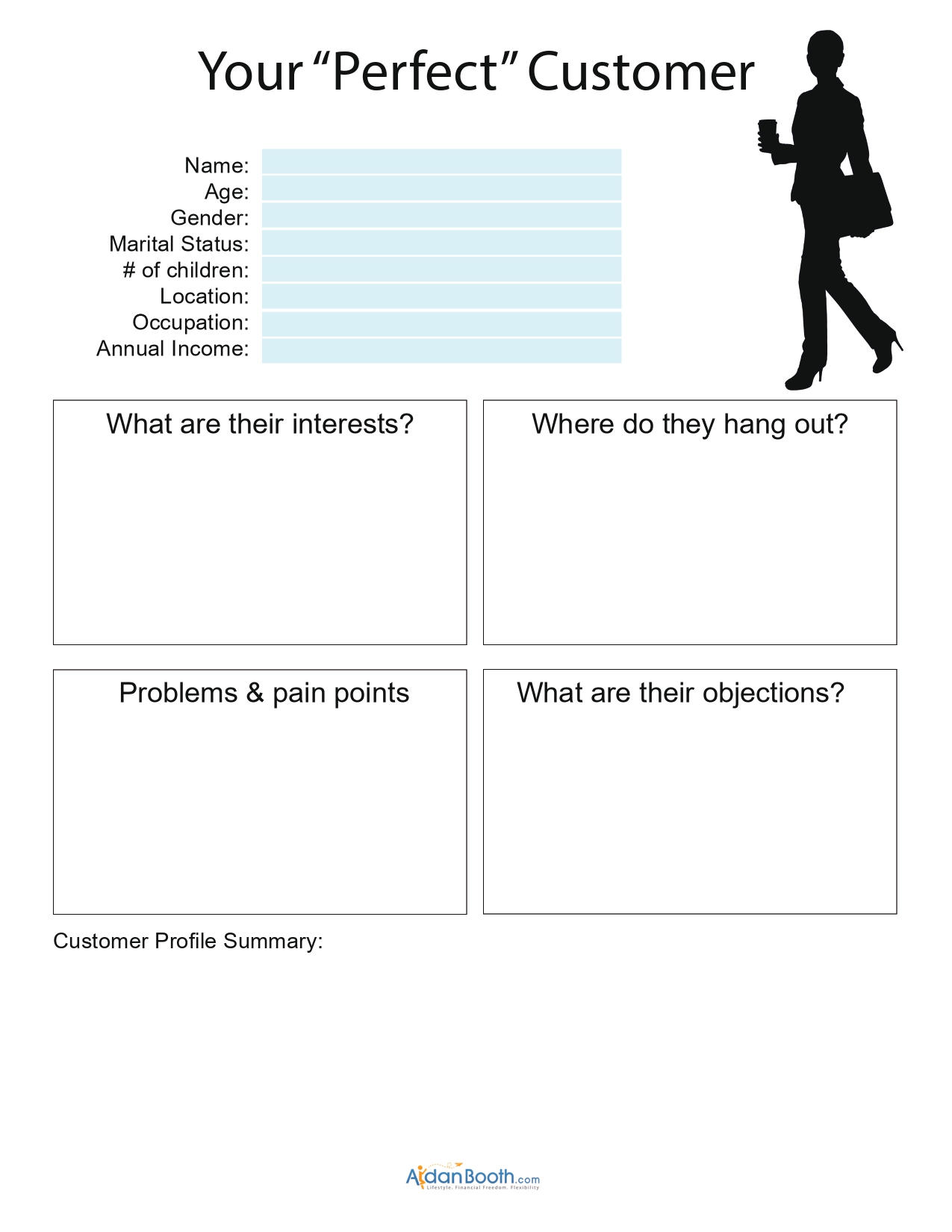
About a decade ago my online business really began to take off… and one of the reasons was because I upped my ‘marketing game’, by focusing more deliberately on Customer Profiles, aka Avatars.
This big-brand marketing strategy can also be used by solopreneurs, it’s not difficult, and I’ll explain more and give you a template you can use in this blog post.
It all starts by asking…
Who is your ideal customer?
That is, who is the perfect person who will buy your product or service?

Sure, you can create your content and then research your target audience, which is what a lot of marketers do, but this is a flawed method. You need to reverse this process and research who would be interested in buying your product or service right at the beginning. Only then do you begin to write your content and marketing strategy.
Knowing who your ideal customer is unlocks a whole new range of profit potential. You are able to get into the mind of your customer, realize their fears and dreams, their lingo and buzzwords, and where they hang out. This way, when you are creating your content and your advertising, you sound like one of them.
Your visitor will read your content and think “Wow, he sounds just like me! He realizes what I like!” They are much more likely to trust you, and your sales and conversions will skyrocket.
When I was still in the early stages of building my online businesses, this technique is the one that helped me accelerate results.
What is a Customer Profile?
To do this, you create what is called a customer profile, or a customer avatar. This is NOT the average customer who visits your business. This is the IDEAL, BEST customer who will 100% buy your product or service.
It consists of a list of descriptions, buying habits and personality attributes that make up the “perfect customer” for what you are selling.
Determining your ideal customer’s profile will help you in creating the type of marketing style that will attract them.
Let’s go through a couple different aspects of your business and see how this tool can make your marketing much more effective:
Content Marketing
What kind of person is most likely to consume your content? What design would attract them? Do they prefer images, video or the written word? What buzzwords and style of writing are they comfortable with?
For instance, if you are selling baby products, your word choices, style, and lingo will be very different than if you are selling in the home rocketry niche.
All types of content, from blog posts to podcasts to social media posts, must be tailored to attract the ideal consumer.
Buying Traffic
Advertising can be expensive, which is why you must target your audience wisely. You should also be able to identify the appropriate platform and where your ideal customer typically spends their time.
You would then create your ads based on the customer profile you created, keeping in mind the headlines, images or video and call to action button that will most effectively attract them.
Copywriting
Words are extremely powerful. By knowing the hopes, fears and interests of your customer, you can more powerfully describe the benefits of your product or service.
Have you ever read a long-form sales page for weight loss (that you know is successful) and immediately rolled your eyes and clicked away? That’s simply because you are not the target audience for the content.
However, let’s say a year from now you are thinking seriously of losing weight. You may read that same ad and nod your head and get excited about the possibilities and dreams of becoming more fit and healthy.
If the copywriter took the time to create a customer profile, they will know exactly how to convince their ideal customer to buy.
Email Marketing
What subject line will excite your ideal buyer the most? What content, stories and advice will keep them interested? What type of wording will compel them to click your links?
How to Create a Customer Profile

The first question you’ll need to answer when determining a customer profile is “What is my product?” or “What are my services?”
For this example walkthrough, let’s say we are selling products in the fitness niche.
To start off, you need to identify your customer’s ideal demographics. This would be the following:
- How old are they?
- Where are they located?
- What is their typical career?
- How much are they earning annually?
- Are they married? Do they have children?
- Did they finish college?
- Do they have pets?
Next, you research the psychographics. That is, everything to do with their lifestyle:
- What do they do in their spare time?
- What is their personality and attitude?
- What are they concerned with?
- What are they interested in?
The third aspect is their behavior and where they consume content. The “where” part of this is important as you want to put your ads and content where they often visit:
- Purchasing behavior (Do they prefer online shopping? Do they window shop? Do they buy on impulse?)
- What are their shopping preferences?
- Do they read blogs? Which topics? What actual websites?
- Do they prefer eBooks over physical books? In what genre?
- What television shows do they watch? Movies? What genres?
- What type of music do they like?
- What devices do they use?
- What social media platforms do they visit the most?
The next thing to identify is their feelings, problems and pain points:
- What are their hopes and dreams?
- What are their fears?
- Who do they look up to?
- What is a problem they have that your product can solve?
Finally, think of their objections. That is, why would they NOT engage with your business?
- What would make them scroll past your ad?
- What would make them not subscribe to your list?
- Why would they not buy your product or service?
- What adjustments can you make to resolve these objections?
To answer all these questions accurately, delve deep into market research. As we are selling products in the fitness niche, we would study the following:
- Fitness forums to read people’s questions and answers
- Relevant Facebook groups to learn the lingo, study how people talk, their wishes, thoughts and personalities
- Fitness blogs to research interests. Pay attention to those posts that receive the post comments
- Fitness magazines. Specifically, study the ads. Since the advertiser is likely paying thousands of dollars for the ad, you can be sure that the ad creator did their own market research first!
- Facebook Audience Insights to discover the demographics info, purchasing behavior and favorite media.
As you study your niche, form a picture in your mind of the ideal person who will buy your product or service.
Customer Profile Worksheet
Use the worksheet below to start making your own customer profile! Using Your Customer Profile
Using Your Customer Profile
Once we have filled out our worksheet, we summarize our ideal customer into a paragraph. Give your buyer a name as well. This is to make them more real to you.
In this example, we call our ideal buyer Alyssa:
Alyssa is a 26-year-old bachelorette living in an apartment in Brooklyn, New York. She has a 9-5 office job that requires her to work overtime almost every day. She recently got engaged, and as a soon-to-be bride, she wants to shed some pounds before her big day. Given her work schedule, she can only squeeze in some workouts at night in her own living room.
With our niche product being fitness equipment, can Alyssa be considered an ideal customer?
Absolutely!
Using Alyssa’s profile, we tailor our content towards providing fitness equipment that can be used at home. Considering she has a busy schedule, we can assume her breaks consist of checking her social media, so we target our ads to appear in Facebook or Instagram, and have weddings and bridal gowns as additional interests to target.
She doesn’t have much time (this is an objection), so our marketing is tailored towards how our product is quick to set up and use. Our content will include material on effective ways to find time to exercise and stay healthy.

Can you create more than one customer profile for your business? Definitely! For every customer profile you build, you need to create tailored marketing content for them as well.
Including this market research to craft your ideal customer has had a huge impact in my business.
What do you think? Have you ever taken the time to create a customer profile? Let me know below!
Thanks for reading, visit again soon!
Aidan Booth







Great stuff Aidan, I used to do a lot of this in corporate actually, it was always a key driver in our marketing strategy.
Yeah, all the big brands use this process, but it seems to be forgotten by many online start-ups!
Thanks for the info, downloaded the worksheet, will be putting this into practice!
Awesome Brent!
This comes at a good time for me, I’m just in the process of releasing my first physical product on Amazon, I can see how this will help with the product positioning. thank you.
Good luck with the launch Martin!
Awesome content and worksheet thanks Aidan. Knowing your customer and using this in ads and ad copy plus in your branding if possible is what will set you apart. Thanks!, Jeff
Very interesting Aidan, I have done a lot of demographic research over the years, marketing, but this layout helps put things more in prospective! Thanks!
Exactly what we’ve been teaching our clients for years….thanks for bringing back to the forefront of our minds!